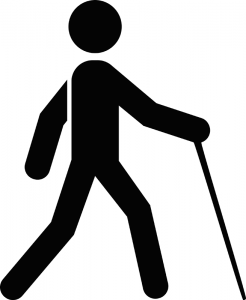Options for Assistive Devices Abound
By Eva Briggs, M.D.
 A few months ago I broke my foot, necessitating crutches first and later a cane, which reminded me that many older patients require assistive devices. It’s estimated that more than 6 million people living in the U.S. use mobility aids to broaden their base of support, to improve balance, to alleviate lower extremity pain, or to compensate for weakness.
A few months ago I broke my foot, necessitating crutches first and later a cane, which reminded me that many older patients require assistive devices. It’s estimated that more than 6 million people living in the U.S. use mobility aids to broaden their base of support, to improve balance, to alleviate lower extremity pain, or to compensate for weakness.
What are some options, and how can you choose and use them correctly?
• Canes help take weight off a painful extremity, improve stability by creating a wider base of support, and aid balance by giving feedback about the ground. Standard canes are the ones that look like a candy cane — a straight shaft with handle on top. Made of wood or aluminum, they’re inexpensive, lightweight, and available at most pharmacies. The aluminum ones are height adjustable.
• Offset canes have a crook forward before the handle curves back, so that the patient’s weight is directly over the shaft of the cane. They’re a better option than a standard cane for someone who needs the cane to bear some weight.
• Quadripod canes have a wider base with four little legs. They are more stable, especially for patients after a stroke or spine injury causing one-sided weakness. Quadripod canes remain standing if the patient must let go to use his/her hands, a plus. But they’re bulky and all four legs must contact the ground for correct use.
• Umbrella handles — curved round like the end of an umbrella — are common but exert pressure on the palm of the hand in a way that potentially compresses nerves, leading to carpal tunnel syndrome. The shotgun handle, named for its resemblance to the shape of a shotgun butt is often found on offset canes and is less likely to cause nerve damage.
The handle of a correctly fitted cane should reach approximately to the wrist crease when the arm is relaxed by the side. This produces a 20-30 degree bend of the elbow. When walking with a cane, it should be held in the hand opposite the weak leg for a natural gait.
• Crutches are particularly helpful for individuals who must use their arms for weight bearing, not simply for balance.
Axillary crutches are the ones most people are familiar with. They’re the crutches that fit under the armpits and are often dispensed by emergency rooms or urgent cares after an acute injury. They’re cumbersome to use. And if fitted incorrectly, they can press into the armpit and damage nerves.
• Forearm crutches, also called Canadian crutches or Lofstrand crutches, have cuffs that encircle the forearm above the hand grips. This permits the user to let go of the handle, for example, to use a railing while climbing stairs, without dropping the crutch.
• Platform crutches have a shelf that supports the patient’s entire forearm. They’re used when hand or wrist weakness prevents gripping a handle, or when the elbow can’t be straightened.
• Walkers help both for balance and weight bearing, but can be bulky, awkward in small spaces, and impossible to use on stairs. Standard walkers must be lifted with each step, making them slow to use and difficult for patients lacking upper body strength.
• Front wheeled walkers don’t have to be lifted with every step. Although they’re less stable than a standard walker, they require less upper-body strength, allow faster forward propulsion, and cause less freezing for Parkinson disease patients.
• Rollators, or four-wheeled walkers, are easier to propel and may have features such as a seat allowing the user to take a rest break. But they are less stable, and cognitively impaired patients or those with balance problems are at risk of falls if the device rolls forward unexpectedly.
Ideally, a patient should be fitted for a trained in the use of assistive devices by a physical therapist. Of course, no assistive device can help if it’s not used. But nowadays there are literally hundreds of options for canes, as well as multiple options for walkers. And there are plenty of accessories available: cupholders, bags, pads, you name it. So if you or a family member needs an assistive device, there’s bound to be the correct one out there.
Eva Briggs is a medical doctor who works at two urgent care centers (Central Square and Fulton) operated by Oswego Health.

